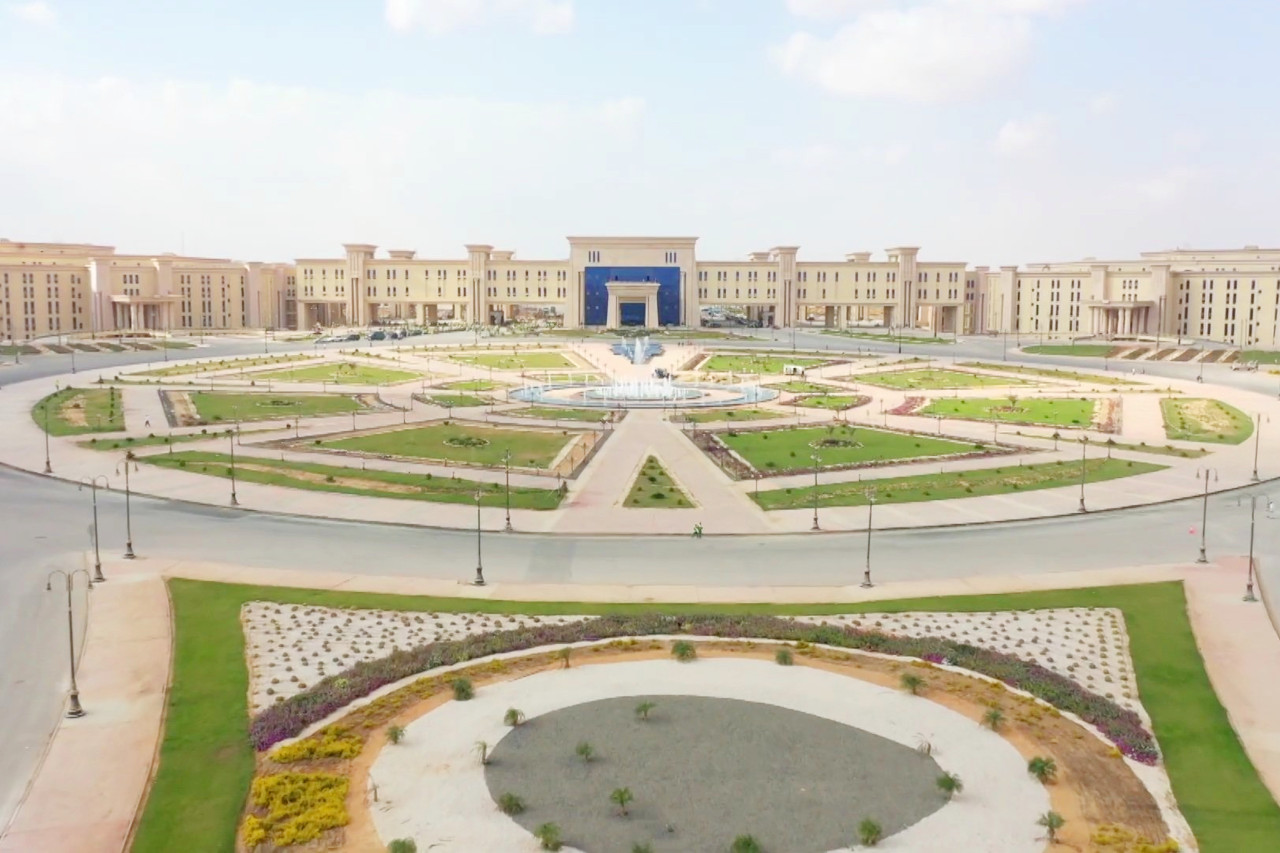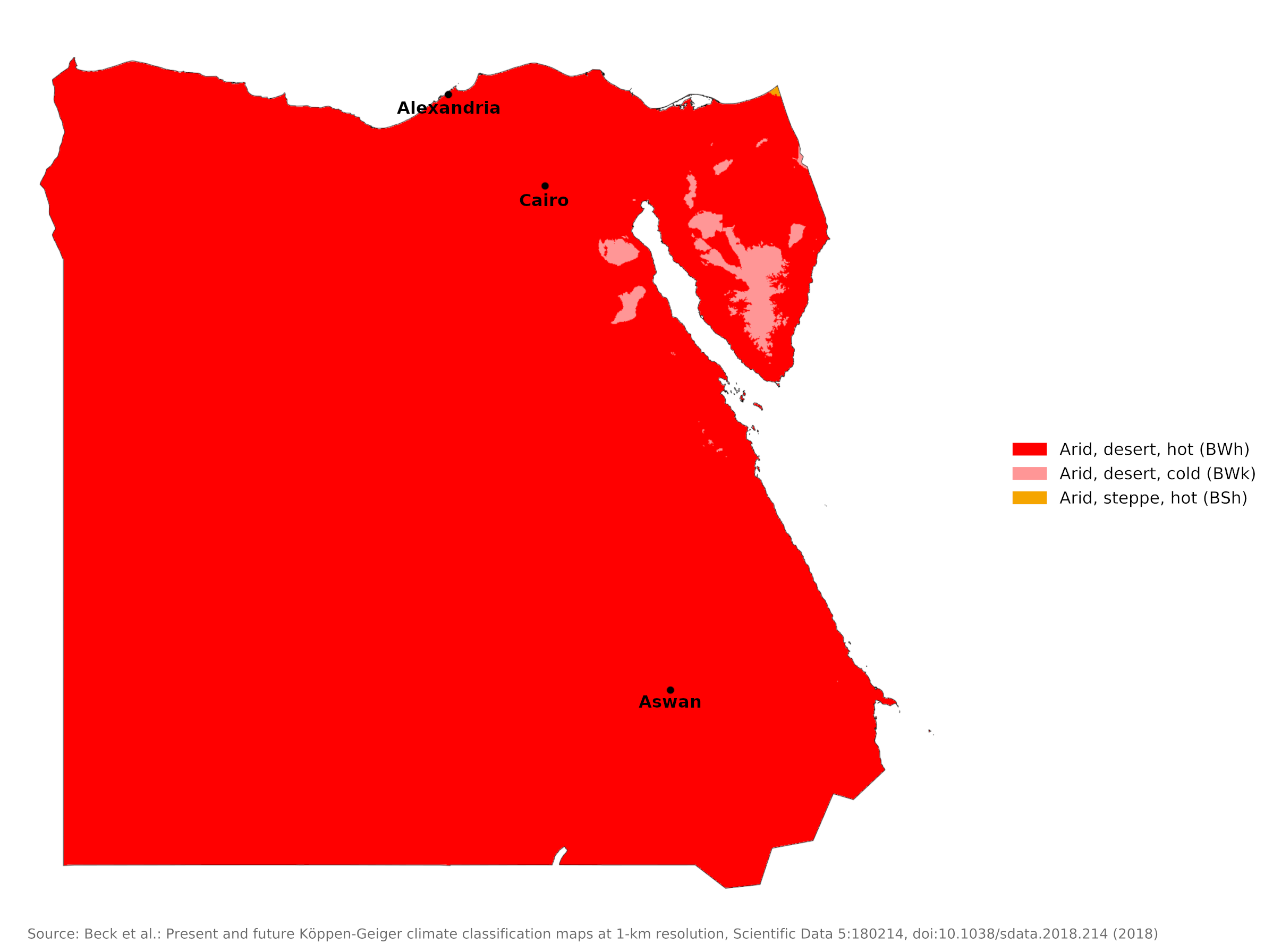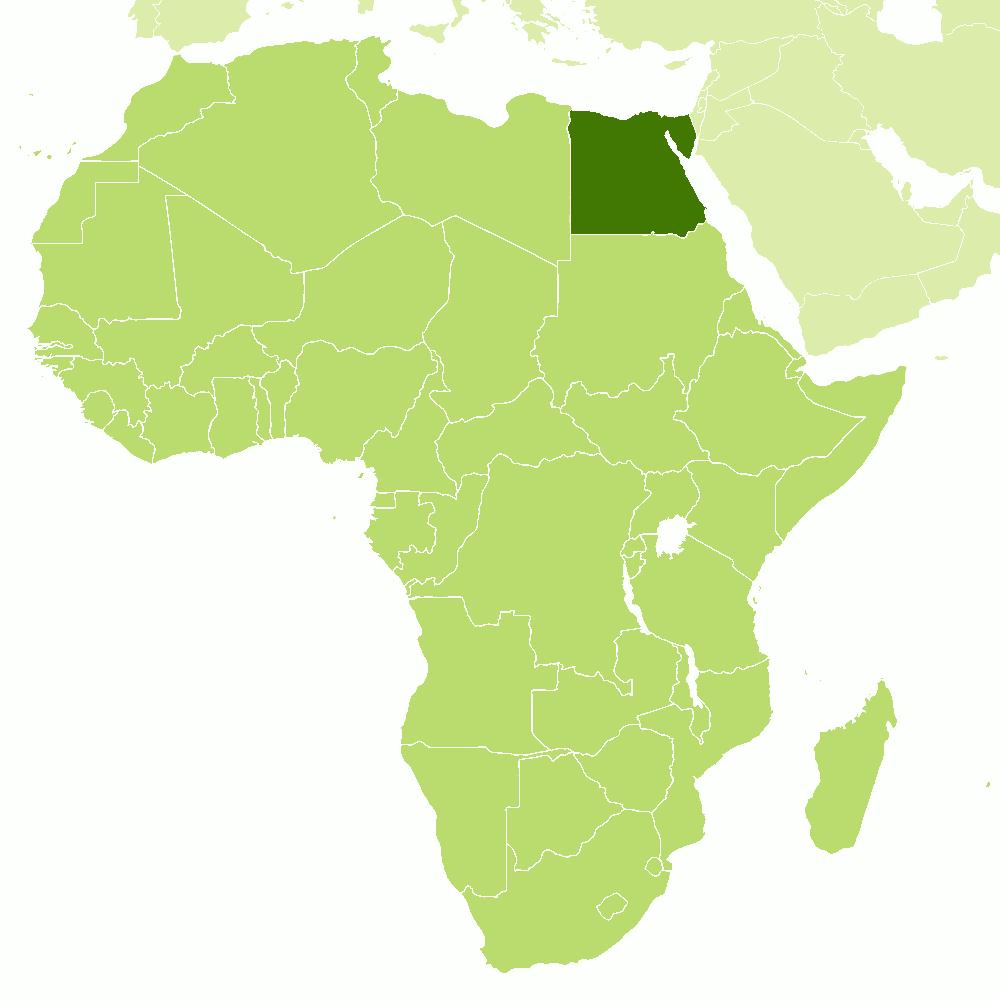The Climate of
Egypt
 'The Octagon', Egypt's new administrative capital
'The Octagon', Egypt's new administrative capital
Climate Map
 Climate map of Egypt
Climate map of Egypt
What is the climate of Egypt like?
Egypt, almost twice the size of France, is located in northeastern Africa. It has long coastlines on the Mediterranean and Red Seas. A small part of the country, the Sinai Desert, lies east of the Suez Canal. Egypt has land boundaries with Libya on the west, with the Sudan on the south, and a shorter boundary with Israel on the east.
Egypt is one of the hottest and sunniest countries in the world. With the exception of an approximately 80 km wide strip along the Mediterranean coast, Egypt has a desert climate as it lies entirely in the Sahara. Egypt has only two seasons: a mild winter from November to April and a hot summer from May to October. The only differences between the seasons are variations in daytime temperatures and changes in prevailing winds.
The legendary fertility of Egypt is due to the fact that about 3% of the country consists of the Nile valley and delta. The Nile has no tributaries within Egypt, but is nourished by the heavy rains that fall in Ethiopia and East Africa far to the south. The Nile Valley and Delta are intensively cultivated through irrigation and are home to most of Egypt's population.
The Mediterranean coastal strip averages 100 to 200 millimeters (4 to 8 inches) of rainfall per year, which is insufficient to support crops. Further south around Cairo, the annual rainfall is only 25 to 50 millimeters (1 to 2 inches). The areas south of Cairo receive only traces of rainfall. In central and southern Egypt, several years can pass without significant rain. When rain does fall, it usually takes the form of a short and sometimes damaging downpour that can cause local flooding.
Sinai receives somewhat more rainfall (about 120 millimeters or 5 inches annually in the north) than the other desert areas, and the region is dotted by numerous wells and oases, which support small population centers that formerly were focal points on trade routes.
The climate of the Mediterranean coast is represented by Alexandria. Here, the average temperature ranges from 13°C (56°F) in December and January to 26°C (79°F) in July and August. The weather in the winter period from November to March can be quite variable, with some cloudy days when rain and weather disturbances are brought by depressions moving west to east in the Mediterranean. Most of the time, however, the winter weather is warm and sunny; but some cold days occur when north winds are strong. Summers are sunny and hot, but the daytime temperature is modified by strong sea breezes on the coast.
| Climate data for Alexandria | |||||||||||||
|---|---|---|---|---|---|---|---|---|---|---|---|---|---|
| Month | Jan | Feb | Mar | Apr | May | Jun | Jul | Aug | Sep | Oct | Nov | Dec | Year |
| Average high °C (°F) | 18.4 (65.1) | 19.3 (66.7) | 20.9 (69.6) | 24.0 (75.2) | 26.5 (79.7) | 28.6 (83.5) | 29.7 (85.5) | 30.4 (86.7) | 29.6 (85.3) | 27.6 (81.7) | 24.1 (75.4) | 20.1 (68.2) | 24.9 (76.8) |
| Daily mean °C (°F) | 13.4 (56.1) | 13.9 (57.0) | 15.7 (60.3) | 18.5 (65.3) | 21.2 (70.2) | 24.3 (75.7) | 25.9 (78.6) | 26.3 (79.3) | 25.1 (77.2) | 22.0 (71.6) | 18.7 (65.7) | 14.9 (58.8) | 20.0 (68.0) |
| Average low °C (°F) | 9.1 (48.4) | 9.3 (48.7) | 10.8 (51.4) | 13.4 (56.1) | 16.6 (61.9) | 20.3 (68.5) | 22.8 (73.0) | 23.1 (73.6) | 21.3 (70.3) | 17.8 (64.0) | 14.3 (57.7) | 10.6 (51.1) | 15.8 (60.4) |
| Average precipitation mm (inches) | 52.8 (2.08) | 29.2 (1.15) | 14.3 (0.56) | 3.6 (0.14) | 1.3 (0.05) | 0.0 (0.0) | 0.0 (0.0) | 0.1 (0.00) | 0.8 (0.03) | 9.4 (0.37) | 31.7 (1.25) | 52.7 (2.07) | 195.9 (7.7) |
| Source: World Meteorological Organization | |||||||||||||
The most striking meteorological factor in Egypt is the year-round north wind, without which the climate would be very strenuous. It is this "Etesian" wind that allows sailboats to travel up the Nile against its current. In December, January and February in Cairo the north wind prevails only slightly, and those from the south and west are often almost equal to it, but after that the north wind blows almost continuously for the rest of the year.
The worst of the weather occurs between March and early June, when a weak low-pressure system draws very hot air from the Sahara towards the coast. These "Khamsin" winds are hot, sand-laden winds of the spring months from the south. They blow gently at first, quickly increasing in intensity before finally falling at sunset. The same thing repeats itself on the second and sometimes the third day, until the wind has turned north again. During a khamsin, the temperature is high and the air extremely dry, while wind-borne dust and sand form a dense yellow fog that obscures the sun. These sandstorms can occasionally damage houses and infrastructure. The very high temperatures that occasionally occur in Alexandria and Cairo almost always occur during the Khamsin season. Otherwise, northern Egypt does not experience the high temperatures that are regularly recorded in the south of the country.
| Climate data for Cairo | |||||||||||||
|---|---|---|---|---|---|---|---|---|---|---|---|---|---|
| Month | Jan | Feb | Mar | Apr | May | Jun | Jul | Aug | Sep | Oct | Nov | Dec | Year |
| Average high °C (°F) | 18.9 (66.0) | 20.4 (68.7) | 23.5 (74.3) | 28.3 (82.9) | 32.0 (89.6) | 33.9 (93.0) | 34.7 (94.5) | 34.2 (93.6) | 32.6 (90.7) | 29.2 (84.6) | 24.8 (76.6) | 20.3 (68.5) | 27.7 (81.9) |
| Daily mean °C (°F) | 14.0 (57.2) | 15.1 (59.2) | 17.6 (63.7) | 21.5 (70.7) | 24.9 (76.8) | 27.0 (80.6) | 28.4 (83.1) | 28.2 (82.8) | 26.6 (79.9) | 23.3 (73.9) | 19.5 (67.1) | 15.4 (59.7) | 21.8 (71.2) |
| Average low °C (°F) | 9.0 (48.2) | 9.7 (49.5) | 11.6 (52.9) | 14.6 (58.3) | 17.7 (63.9) | 20.1 (68.2) | 22.0 (71.6) | 22.1 (71.8) | 20.5 (68.9) | 17.4 (63.3) | 14.1 (57.4) | 10.4 (50.7) | 15.8 (60.4) |
| Average precipitation mm (inches) | 5.0 (0.20) | 3.8 (0.15) | 3.8 (0.15) | 1.1 (0.04) | 0.5 (0.02) | 0.1 (0.00) | 0.0 (0.0) | 0.0 (0.0) | 0.0 (0.0) | 0.7 (0.03) | 3.8 (0.15) | 5.9 (0.23) | 24.7 (0.97) |
| Source: World Meteorological Organization | |||||||||||||
The average annual temperature increases moving southward from the Delta to the Sudanese border, where temperatures are similar to those of the open deserts to the east and west. Winters are generally warm in southern Egypt, but temperatures drop quite abruptly at night, so winter desert evenings can be quite chilly (such as Aswan). Further north, nights can be decidedly cool and occasional ground frost is not unknown. In the Nile Valley, moisture from the large irrigated areas causes local morning fog and mist, especially in winter, but this quickly dissipates when the sun gets strong. Snow can fall in winter on the higher hills of Sinai behind the Red Sea coast, rising to 2,000–2,400 meters (7,000–8,000 feet), but it rarely lasts more than a day or so.
| Climate data for Aswan | |||||||||||||
|---|---|---|---|---|---|---|---|---|---|---|---|---|---|
| Month | Jan | Feb | Mar | Apr | May | Jun | Jul | Aug | Sep | Oct | Nov | Dec | Year |
| Average high °C (°F) | 22.9 (73.2) | 25.2 (77.4) | 29.5 (85.1) | 34.9 (94.8) | 38.9 (102.0) | 41.4 (106.5) | 41.1 (106.0) | 40.9 (105.6) | 39.3 (102.7) | 35.9 (96.6) | 29.1 (84.4) | 24.3 (75.7) | 33.6 (92.5) |
| Daily mean °C (°F) | 15.3 (59.5) | 17.5 (63.5) | 21.8 (71.2) | 27.0 (80.6) | 31.4 (88.5) | 33.5 (92.3) | 33.6 (92.5) | 33.2 (91.8) | 32.8 (91.0) | 27.7 (81.9) | 21.5 (70.7) | 16.9 (62.4) | 25.9 (78.6) |
| Average low °C (°F) | 8.7 (47.7) | 10.2 (50.4) | 13.8 (56.8) | 18.9 (66.0) | 23.0 (73.4) | 25.2 (77.4) | 26.0 (78.8) | 25.8 (78.4) | 24.0 (75.2) | 20.6 (69.1) | 15.0 (59.0) | 10.5 (50.9) | 18.5 (65.3) |
| Average precipitation mm (inches) | 0 (0) | 0 (0) | 0 (0) | 0 (0) | 0.1 (0.00) | 0 (0) | 0 (0) | 0.7 (0.03) | 0 (0) | 0.6 (0.02) | 0 (0) | 0 (0) | 1.4 (0.06) |
| Source: World Meteorological Organization | |||||||||||||
The heat of southern Egypt in summer is very strong and there is almost no relief from one day to the next. However, the very low humidity makes the heat more bearable and rarely dangerous to the acclimatized visitor. Visitors should allow themselves a period of acclimatization before engaging in intense activity during the heat of the day. Shade temperatures are misleading in Egypt where the sun is omnipresent and there is no shade in the desert. However, the temperature drops rapidly after sunset due to the high rate of radiation when the sky is clear.
Except for areas along the Mediterranean coast, where winter rains are common, Egypt's harsh desert climate sees little to no rain. During the summer months, even the coast receives little or no rain. As a result, droughts and storms (the "khamsin") are frequent. Annual rainfall averages 25 millimeters (1 inch) south of Cairo and 200 millimeters (8 inches) on the Mediterranean coast, but sudden storms sometimes cause flash floods.
Egypt has a very sunny climate: the daily hours of sunshine average around twelve in summer and between eight and ten in winter. In the north there are occasional completely cloudy days in winter, but very few in the south. Places like Luxor and Aswan and the few oases in the Sahara have a very pleasant winter climate: dry, sunny and not overly hot.
References
- E. A. Pearce, Charles Gordon Smith, (1990) The Hutchinson World Weather Guide, John Murray Press. ISBN 1859863426
- Timothy L. Gall, (ed.), (2003), Worldmark Encyclopedia of the Nations, Eleventh Edition, Thomson Gale
- Federal Research Division, Library of Congress, (1991), Egypt: a country study. Claitor's Pub. Division. ISBN 0844407291
- Hugh Chisholm, (ed.), (1911), Encyclopædia Britannica, Eleventh edition, Cambridge University Press
The Climate of
Egypt

In summary:
Except for the areas along the Mediterranean coast, Egypt has a dry, desert climate. Northern winds temper the climate along the Mediterranean, but the interior areas are very hot.
The northern coast has dry summers and some winter rain, but elsewhere rainfall is scarce to nonexistent.